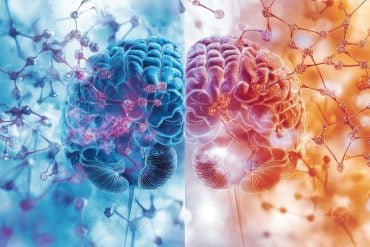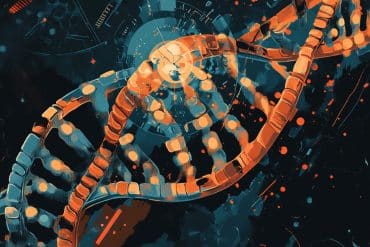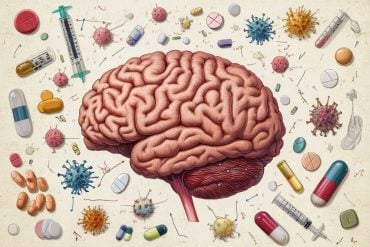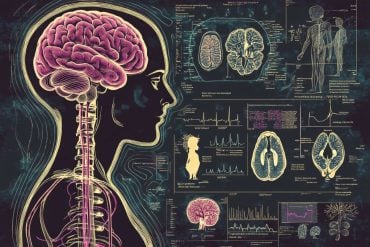Summary: At the age of five months, children who are later diagnosed with autism show different activity in the visual cortex when viewing certain types of movement. Findings reveal those with ASD experience differences in perceptions of their surroundings from a young age, and this may affect their learning and overall development.
Source: Uppsala University
A new study from researchers at Uppsala University and Karolinska Institutet shows that children who go on to develop symptoms of autism have different activity in their brain’s visual cortex from as early as five months when looking at certain types of movement.
This finding may indicate that autistic people perceive their surroundings in a different way even from a very young age, which could affect their development and learning.
Autism is defined by challenges with social communication together with restricted and repetitive features in behavior and interests.
However, research shows that autistic people also have a different perception of and reaction to various stimuli. In particular, many studies have shown a connection between autism and difficulties in perceiving whole units in visual movement patterns—such as when a flock of birds forms a common movement in the sky.
Being able to integrate movement signals into an overall figure is important in terms of the ability to correctly perceive how objects and surfaces move in relation to the viewer.
The new study, published in Communications Biology, examined activity in the brains of five-month-old infants sitting on their parents’ laps while viewing different types of visual information.
The researchers measured both how the brain reacted to simple visual changes in light (such as a line changing direction) and more complex patterns where the ability to see whole units was put to the test.
The assessment used EEG technology, which records weak electrical signals created naturally in the brain’s cerebral cortex when processing information. The signals were measured using electrodes placed around the head on a specially adapted cap.
The infants who later on—at age three—exhibited many of the classic symptoms of autism had different brain activity when complex movement patterns were shown on the screen.
This suggests that the brains of autistic people process visual motion differently from early infancy. Simpler visual changes, on the other hand, produced a clear and similar response in all of the children’s brains.
“Seeing this difference several years before the symptoms of autism develop is something completely new, and contributes to our understanding of what early development looks like in autism. Autism has a strong hereditary component, and it is likely that the differences we see in visual perception in infancy are connected to genetic differences,” explains Terje Falck-Ytter, Professor at the Department of Psychology at Uppsala University and principal of the study.
“We can only guess at the infant’s subjective experience of visual motion. However, given the results and previous studies of the relationship between brain activity and experience in adults with the diagnosis, it is plausible to believe that they experience it in a different way.

“It is also possible that this finding is related to the perception of complex social movement, such as the interpretation of facial expressions. This is something we want to investigate in future studies.”
The study is part of the larger research project EASE (Early Autism Sweden), a collaboration between Uppsala University and the Center of Neurodevelopmental Disorders at Karolinska Institutet (KIND).
When the children were three years old, a standardized play observation was carried out with a psychologist, and based on this, each child received a score corresponding to symptoms of autism.
The study also included a control group of over 400 infants, meaning the researchers had good knowledge of how children’s brains usually react to these stimuli.
“Autism cannot currently be diagnosed with good accuracy until around two to three years of age, but we hope that more knowledge about early development will enable us to make these assessments earlier in the future. This would make it easier for families to get support and hopefully individualized training sooner. It could also stimulate completely new research into early interventions.
“The results of this study showed statistically significant differences between groups, but it is important to emphasize that the accuracy of the EEG measurement was too low to be able to predict the development of individual children. It is therefore too early to tell whether this method will have clinical value for early detection, for example,” concludes Falck-Ytter.
About this ASD research news
Author: Press Office
Source: Uppsala University
Contact: Press Office – Uppsala University
Image: The image is in the public domain
Original Research: Open access.
“Global motion processing in infants’ visual cortex and the emergence of autism” by Irzam Hardiansyah et al. Communications Biology
Abstract
Global motion processing in infants’ visual cortex and the emergence of autism
Autism is a heritable and common neurodevelopmental condition, with behavioural symptoms typically emerging around age 2 to 3 years. Differences in basic perceptual processes have been documented in autistic children and adults.
Specifically, data from many experiments suggest links between autism and alterations in global visual motion processing (i.e., when individual motion information is integrated to perceive an overall coherent pattern).
Yet, no study has investigated whether a distinctive organization of global motion processing precede the emergence of autistic symptoms in early childhood.
Here, using a validated infant electroencephalography (EEG) experimental paradigm, we first establish the normative activation profiles for global form, global motion, local form, and local motion in the visual cortex based on data from two samples of 5-month-old infants (total n = 473).
Further, in a sample of 5-month-olds at elevated likelihood of autism (n = 52), we show that a different topographical organization of global motion processing is associated with autistic symptoms in toddlerhood.
These findings advance the understanding of neural organization of infants’ basic visual processing, and its role in the development of autism.







